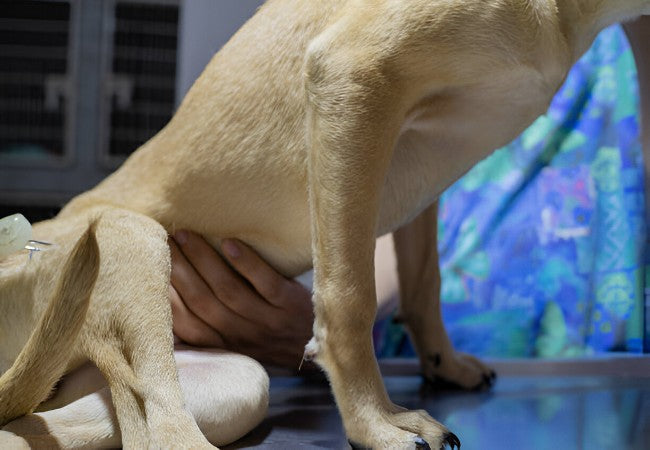Muscle Rupture in Dogs – Vet‑Led Guide 2025 🐕💥

In this article
🩺 Muscle Rupture in Dogs – Vet‑Led Guide 2025 🐕💥
By Dr. Duncan Houston BVSc
Hello, I’m Dr Duncan Houston, BVSc, founder of Ask A Vet. Muscle ruptures—tears in muscle fibers or musculotendinous junctions—can cause acute lameness and pain. Early care, accurate diagnosis, and tailored rehab ensure the best recovery. Let’s dive into what you need to know to support your dog through every step of healing. 🩹
⚙️ What Is Muscle Rupture?
A muscle rupture is a tear in muscle fibers or at the musculotendinous junction (where muscle meets tendon). Injuries range from minor strains to complete tears—including tendon rupture like the Achilles tendon “dropped hock” scenario.
🚩 Common Causes & Risk Factors
- Exertional trauma: sudden sprinting, jumping, rough play—frequent in active/agile dogs.
- Overuse: repetitive stress injuries like supraspinatus tendonitis in working breeds.
- Acute blunt trauma: falls, collisions, lacerations.
- Age and preexisting strain: degeneration, obesity, and previous sprains increase risk.
🚨 Signs & Symptoms to Watch For
- Sudden limping, favoring limb, reluctance to bear weight.
- Pain at injury site—heat, swelling, tenderness.
- Muscle stiffness, partial stance or collapse in severe tendon tears.
- Altered gait—flat-footed or dropped “hock” if Achilles involved.
- Muscle atrophy or contracture is chronic/unmanaged.
🔬 How We Diagnose It
- History & physical exam: acute onset, palpation reveals pain/swelling.
- Imaging: X-rays to rule out bone fractures; ultrasound/MRI visualizes muscle/tendon tears.
- Diagnostic ultrasound: especially for iliopsoas or supraspinatus injuries.
- Gait analysis: force plates or video to assess weight-bearing and muscle engagement.
- Lab work: baseline bloodwork to assess overall health and plan surgery or meds.
💊 Treatment Strategies
1. Conservative Management (Partial Tears)
- Strict rest—crate or area confinement for 2–4 weeks initially.
- NSAIDs for pain and inflammation (e.g., carprofen, meloxicam).
- Cold compress initially, then warm compress after 48 hrs to promote circulation.
- Controlled passive range-of-motion and physical therapy after 48 hrs.
- Bracing or compression wraps for support in some cases.
2. Surgical Repair (Complete Tears)
- Surgery is typically after swelling subsides, 2–3 days post-injury.
- Gastrocnemius/Achilles tears: suture repair + external coaptation for 4–8 weeks.
- Musculotendon injuries: use of pins/screws or casts as needed.
- Post-op strict rest—usually 2–3 months of restricted activity.
- Physical therapy: hydrotherapy, laser therapy, coordination exercises begin early and progress.
📅 Recovery & Prognosis
- Partial tears: often heal well within weeks; most regain normal function.
- Complete tears: with proper surgery and rehab, prognosis is good to excellent—80–100% return to activity.
- Performance dogs: may need longer confinement and careful rehab to return to sport.
- Chronic, untreated cases: risk scar contracture, long-term lameness, and muscle atrophy.
🏡 At‑Home Care & Monitoring
- Keep the restricted area calm—no stair access, no rough play.
- Administer all medications as prescribed—don’t skip NSAIDs.
- Perform gentle passive motion exercises as guided by rehab vet.
- Monitor pain, swelling, appetite, mood daily.
- Gradually reintroduce leash walks at 4–6 weeks post-injury or surgery.
🎯 Prevention Tips
- Keep your dog healthy weight to reduce strain.
- Warm up before activity: short walk before play sessions.
- Avoid high-risk activities like rough pivoting, early jumping, especially in young pups.
- Provide consistent physical conditioning—regular exercise, strength-building activities.
- Regular check-ups at rehab or vet to spot early strain signs.
🐾 Supporting Owners & Pets
Need guidance through recovery? Chat 24/7 with Ask A Vet about pain management, rehab protocols, or signs to watch. With expert support and care, your dog’s healing journey can be smooth and successful. 💪❤️
✨ Key Takeaways
- Muscle rupture ranges from mild strains to full tendon tears—prompt care promotes best healing.
- Proper diagnosis uses history, palpation, imaging, and gait evaluation.
- Partial tears can heal with rest + NSAIDs + physical therapy; complete tears need surgery.
- Veterinary rehab (hydrotherapy, laser, PT) is central to full recovery.
- Home care, prevention, and supportive tools reduce recurrence and improve outcomes.
- With timely care, dogs often regain full function and quality of life, and bonding continues! 🐾
If your dog suddenly limps, shows pain, or you suspect a muscle injury, don’t wait. Contact your veterinarian or Ask A Vet to guide assessment and recovery every step of the way. 📞






